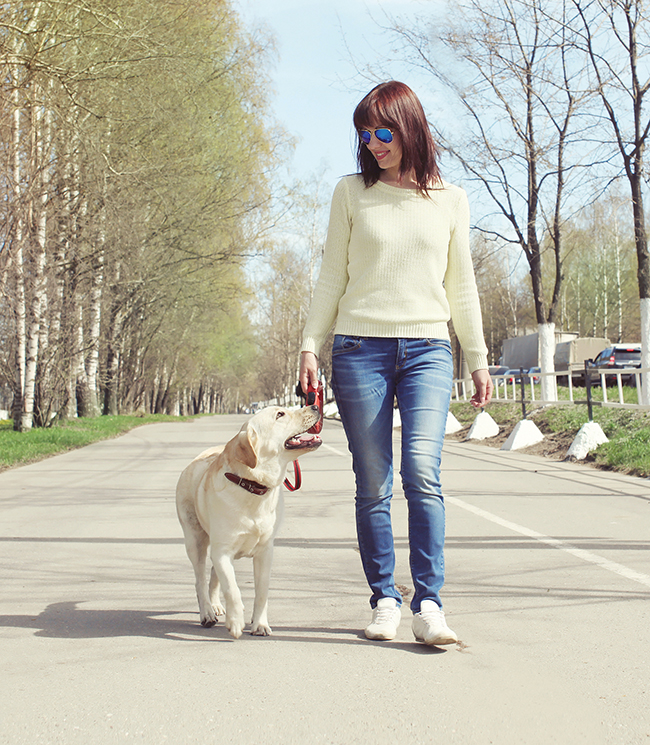They are brilliant for bonding and for discovering more about your environment, says top trainer and behaviourist Jackie Drakeford.
Do you sometimes catch yourself thinking about how quickly you can get this walk over? Dogs are well aware when we are not paying them attention, and react in different ways according to their breed bias. Some will niggle at us to interact with them; some will try to get other people and dogs to give them the social exchanges they crave — and not always in a nice way; others will quietly slope off to do their own thing, which is usually not something we want either. Here are some ideas for making walks more interesting and fulfilling for dogs and humans alike.
Don’t take calls and check on social media on your dog’s walks.
1. Put electronic devices away!
This is no time for checking out social media or catching up on phone calls. It is terribly disrespectful to your dog, draining your precious together time. And don’t find other distractions either — I used to meet someone who would walk along reading a book! While being impressed at her ability to do so without falling over, her dogs were visibly miserable at her lack of interaction with them.
Make sure your walks are all about you and your dog.
2. Go round the other way
Especially in winter, we can be restricted with the routes we are able to take. Paths become waterlogged, lack of daylight makes the woods too dark, livestock is moved to different fields, and some areas are temporarily closed due to sporting interests. Maybe try setting off in the reverse direction. It can present a sufficiently different aspect to add interest, especially from a dog’s point of view. Even pavement walks in towns offer different scents if we walk on the other side or round the opposite way.
Walks also present an opportunity to practise and proof your training.
3. Train!
Training is not proofed until it works in a variety of circumstances, so once an exercise is reliable at home, it needs to be built upon outside in the real world. Do this by increments, and avoid asking for too much, too soon.
Be aware that while for some dogs training is the best fun ever, for others it can quickly become a bore (why exactly are we doing this?) so while, for instance, you can aim for better and slicker standards with your Border Collie, once or twice is quite enough for your Borzoi.
Learn from observing your dog’s scenting abilities.
4. Let your dog teach you
Though we have superior colour vision, dogs’ eyes are better at detecting movement, especially in low light. Dogs’ senses of hearing and scent detection are far better than ours as well.
Identify the wind direction before you set off on your walk, because this is where your dog will be getting a lot of sensory information. Sounds can carry a long way in the wind, though if it is blustery it can mask the precise direction of the source, and it’s the same with scent, which can be on the ground or in the air.
Working dog people know that when the ground is warmer than the air, scent is trapped between the temperature layers as it rises, whereas when the air is warmer than the ground, scent is carried upwards until it disperses. Wet ground holds scent better than dry, and very hot conditions evaporate scent extremely quickly.
All this your dog will tell you as he snuffs up different smells, sometimes looking upwards, sometimes following trails across the ground. At the same time, his ears will move to intercept sound, which is easier for some breeds than others depending on the ears.
Walks are a great bonding opportunity.
5. Set yourself a challenge
Get inspired to walk together by setting yourself a goal. You could aim to complete a certain number of miles, cover a geographical area, take in certain landmarks, make it part of a weight loss mission, or even do Geocaching. You could raise money for charity or just do the challenge for fun. Either way, making it a challenge can provide that extra motivation, which is particularly helpful for times when you’re tempted to just get the walk done with.
6. If your dog enjoys retrieving...
Include a few ‘find and retrieve’ exercises in your walk. Start with dropping a suitable item on the path behind you in plain sight, walk on a few paces, then send your dog back to pick it up and return. Progress to walking further before you send him, then conceal the item and find it together, and when he has that sussed, send him on his own. Only do these exercises when there is no risk of another dog coming along and snaffling the item, which may trigger a scrap.
7. Know your breed types
Look for unusual dogs that you see on your walks. Is that a cross-breed such as a Cockerpoo, or a rare pedigree such as a Clumber Spaniel or an Otterhound? It can be fun to work out what ‘ingredients’ there are in a Lurcher or a Heinz-57 one-of-a-kind. Feet, ears, tail, coat, and colour are good guides, and it’s just a bit of fun so nothing to worry about if you get it wrong.
Walking is one of the most enjoyable aspects of dog ownership.
8. Identify the scent
Watch your dog as he picks up a scent, and try to work out what it is. If he tracks a short distance and then looks up a tree, it was probably a squirrel, whereas if he is now snuffling around some rabbit holes — well, you guess! A pheasant will walk along in a series of pauses, checking here, eating something there, and can meander quite a long way before it flies off. If your dog shows great interest in a scent and then wees on top of it, possibly turning right round and standing on tippy-toes to get his contribution in exactly the right place, it’s another dog, and he is showing his equivalent of checking the weemails. If he hackles up and backs off or barks, this often indicates a creature such as a badger or a hedgehog has passed by.
9. Understanding your surroundings
Are those deer slots or sheep prints? Is that the padmark of another dog or a fox? Are those webbed feet marks from water birds or a mink? What does that pile of feathers indicate?
Find what the old country people call ‘trade’ where wild animals follow the same route from one place to another, so creating a path through the undergrowth. Fox and deer trade is narrow, while badger trade is a badger-width across. The ground tells many tales.
Many dogs enjoy grazing while out on their walks.
10. Wild plants
Dogs love to graze on different herbage, and at certain times of year they really enjoy fresh green shoots. Learn to identify what they like best, such as cleavers, which are rich in vitamins and beneficial minerals, as well as newly sprouting grasses of different types. Who thought there were so many varieties of grass? But our dogs know. They love some types — couch grass is also known as dog grass — and take no notice of others. Don’t let your dog eat farm crops though, because not only are they the farmer’s living but they may have been sprayed with chemicals or have had slug pellets scattered in them.
Similarly, while most dogs are careful to avoid poisonous plants, some eat first and ask questions later. If yours is a gannet, steer him resolutely away from any plant life you aren’t sure of, and never let any dogs eat fungi.
Plan a special walk
Walking is a regular part of dog owner’s routine, but sometimes it’s really nice to go somewhere for a walk with a difference. Plan a dog walk with something extra special to see and do. You may need to hop in the car first, but it can be a great day out together. You’re sure to enjoy it and, best of all, your dog will pick up on it. We all know dogs have an instinct for how we’re feeling. When you’re not feeling the walk, your dog will pick up on it. And if you’re having a brilliant time, they’re likely to, too! Here are some ideas for a special dog walk:
- Dog-friendly beach – who doesn’t love the beach? Just ensure your chosen destination permits dogs for when you plan to go.
Your Dog recommends: Holkham Beach – the stunning sandy expanse welcomes dogs all year round and over 70% is open to off-lead walking
- Historical site – the National Trust welcomes dogs to many of their outdoor spaces, while you there are also castles.
Your Dog recommends: Caerphilly Castle – dogs are allowed to explore the ground floor levels of the caste. Visit cadw.gov.wales/visit/places-to-visit/caerphilly-castle
- Forest and woodland – delightful plants and trees can provide welcome shade and interesting sites and sounds.
Your Dog recommends: Westonbirt Arboretum – with a range of walks and off-lead opportunities, and the chance for a doggy ice cream when you finish. Visit forestryengland.uk/westonbirt-the-national-arboretum
- Waterfall walks – the UK has some stunning waterfalls that you can visit with your canine companion.
Your Dog recommends: Ingleton Waterfalls Trail – the stunning trail takes around two and a half hours to complete and dogs are welcome on leads. Visit ingletonwaterfallstrail.co.uk
- Country parks – there are some fantastic parks across the country that welcome dogs.
Your Dog recommends: Hampstead Heath – with off















